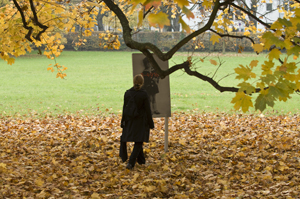Home

© Eva & Artur Holling

© Eva & Artur Holling

© Eva & Artur Holling
“We have been saved, but we are not liberated.”
Norbert Wollheim, August 26, 1945
The Norbert Wollheim Memorial is named for Norbert Wollheim (1913–1998), a survivor of the Buna/Monowitz concentration camp. He had to perform forced labor for I.G. Farben at the construction site in Auschwitz. In 1951 he filed a suit against the conglomerate in a test case seeking compensation. The Wollheim Memorial combines commemoration of the victims of Buna/Monowitz with information about the history of their persecution and compensation.
The site of the Norbert Wollheim Memorial is the I.G. Farben Building, which now houses the humanities and cultural studies departments of the Goethe-Universität in Frankfurt am Main. Here, next to the former headquarters of one of the world’s largest chemical corporations, photographs in the park point the way to a small pavilion on the edge of the property. The photographs, portraits of young people who later were prisoners in the Buna/Monowitz concentration camp, illustrate Jewish daily life before the Holocaust and bear witness to lifeworlds that have been destroyed. A number is displayed above the pavilion’s door: 107984, Norbert Wollheim’s prisoner number. Inside the small building, visitors see a wall inscription and two video screens. In 24 video interviews, survivors of the Buna/Monowitz concentration camp talk about their childhood and youth in various places in Europe, their deportation, confinement in the camp, and their lives after the Holocaust. A dual-language website with introductory and in-depth texts, pictures, and documents enables visitors to place the accounts in the proper context. Historical information and documentation regarding I.G. Farben, its corporate concentration camp Buna/Monowitz, and forced labor in the National Socialist era are supplemented by a presentation of the history of the legal system’s coming to terms with the legacy of National Socialism and the campaign for payment of compensation for forced labor in the Nazi system. Ways of remembering the Holocaust are presented, and questions about bearing witness and commemoration are posed. Here, too, the testimonies of the survivors of Buna/Monowitz are at the center.
Educational Offerings and Guided Tours
at the Norbert Wollheim Memorial
















